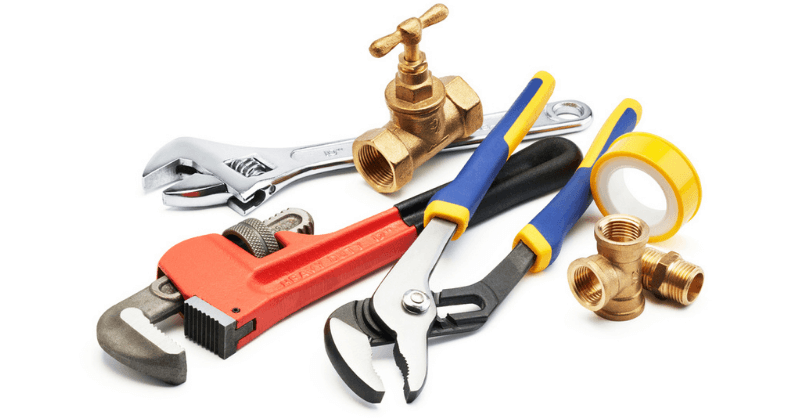One of the most fun and enjoyable part of a plumbing job is you get to use a wide range of unconventional tools and accessories in order to carry out an odd plumbing operation. Plumbing tools are dedicated to serving the unique needs of a plumber who is entrusted with the unorthodox challenge of plumbing.
As a plumber, you may be called up to treat leaking pipes, clogged up drains, repair & install bathroom fittings and fix room heaters & boilers that keeps the hot water supply running. It’s not very often we notice the tools that assist him to carry out.
To start off as a beginner, you must make a list of plumbing tools that will help you carry out your work precisely and improve your performance. Here is a slight peek for you into a plumber’s toolbox.
Some of the basic hand tools used by a plumber are:
Screwdriver: A screwdriver is a basic common handtool used for screwing and unscrewing screws. It can be both manual and automatic.
Pliers: Plumbing pliers are used to turn and hold nuts and bolts, gripping irregularly shaped objects and clamping materials. They are of various size shapes and designs according to their uses. Some are even designed for a combination of tasks.
Wrench: A wrench or in other terms a spanner is a tool used to provide grip and mechanical advantage in applying torque while turning objects. They are used on nuts and bolts to keep them turning. There are both fixed and adjustable wrenches of different sizes and shapes.
Wilder: Using a welder is one of the effective ways to join two or more metals that similar qualities. A professional welder has their own welding technique. Some welders work with a pulling motion, while others use pushing motion, depending on the type of welding being done.
Pipe wrench: A pipe wrench is so synonymous to plumbing that it is like a symbol for the plumbing profession. It is a special type of wrench designed to turn threaded pipe and pipe fittings for assembly and disassembly.
Related:
2. What Qualifications Do I Need To Be A Plumber?
Saw: Saws are very essential to carry out plumbing operations. They aid in cutting through plastic and wooden materials. Both hacksaws and handsaws are necessary to cut through various types of pipes according to the quality of precision required.
Drain rods: These are the long rods that are pushed through the pipes in case of any blockage to loosen up the blockage. They are pushed up and down, twisted and turned to clear up the clogging. bendy drain rods go through awkwardly shaped pipe systems and tight turns.
Flang plunger & Cup plunger: Plungers have a curved flap below the lip that creates a seal in the tight and curved shape spaces such as sinks and toilet bowls. This mechanism traps air which frees up clogging in long pipes and complex drainage systems. Flange plungers are mainly used for toilets and cup plungers for sinks.
Mains tester: As a plumber, you might sometimes need to work with electronics as well so a mains tester is a simple electronic device used to see the flow of current through a circuit which also works as a screwdriver.
The above were some basic tools used in plumbing. Some intermediate and advanced tools used by plumbers to repair and fix bathroom fittings and clogged pipes are as follows:
Sink auger: A sink auger is a tool that reaches down into pipes. It is used to clean up clogs in sinks and bathtub drains. Its a cable with corkscrew end. The cable is coiled and attached to a drum canister.
Pipe cutter: A pipe cutter is used to make a clean cut through pipes in order for them to fit the requirements.
Cordless drill: Drills are used for making holes or to attach fasteners on all kinds of surfaces. They are attached a bit to drill through the necessary surface.
plumbing solder: Acid core solders are used in plumbing applications to join metal pipes or sheet metal.
Apart from the above tools, there are several accessories needed to carry out a regular plumbing operation.
Some of the basic accessories used in plumbing are as follows:
Faucet packing o-rings: faucet O-rings prevent water from oozing out around the spout. Once they are worn out they may cause leakage. So carrying a few of these accessories may be a lifesaver for you.
Plumbing tape: plumbing tape also known as Teflon tape is used to get a watertight seal on threaded pipe joints. It also makes threading a bit smoother and prevents pipes from sticking. Any leaks can be immediately covered by a Teflon tape.
Measuring tape: measuring tapes are essential for measuring lengths and distances. The work of plumbing involves accomodating pipes in the available spaces and all that for which measurement is essential.
Handheld flashlight: at work plumbers often need to work in uncomfortable positions and places where a flashlight may be necessary to get a clear view of a thing.
Like all other hands-on jobs the plumbing also carries a few risks. Some safety equipment worn and maintained by plumbers are as follows:
Soldering mat: soldering mat is used to prevent damage to the walls and pipes while operating working with solder.
Goggles: while working in a relevant situation where the eyes may be in risk of heat or dust the use of google is a must.
Gloves: gloves are a key safety accessory for plumbers. As the plumber’s job is can be sluggish at times and you may have to stick your hands into dirty pipes and sewerage lines. The use of gloves is a norm in some of the plumbers day to day works.
Kneepads and headgear: Though these are not always necessary for household works they are absolutely necessary to carry out industrial plumbing works.
If you are struggling with your plumbing work, then contact a professional. Click here to find out more about their amazing service.
Read More:
1. How to Become a Plumber: Explore Jobs & Career paths
2. What Qualifications Do I Need To Be A Plumber?
Recent posts
- The Impact Of Remote Work On Women In The Marketing Industry
- 5 Reasons Why You Should Pursue a Cybersecurity Career
- Differentiating Web Design and Web Development
- Top 10 Social Media Management Tools for Businesses in 2024
- Why is Child Development so Important in Early Years
- Line Management: How to be a Good Line Manager?
- How Long Should a Health Sector Career Take?
- The Importance of BSL in Everyday Life
- Why Corporate eLearning is Essential for Organisational Training
- Take your Business Expertise to the next level: Get your MBA







 April 07, 2020
April 07, 2020








